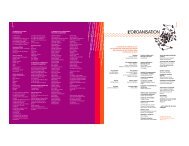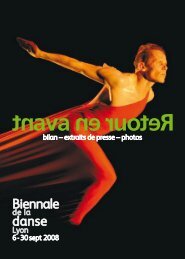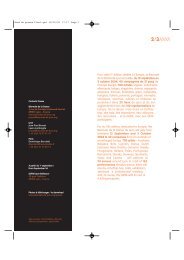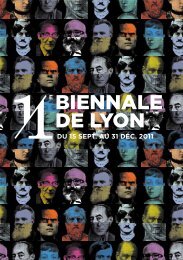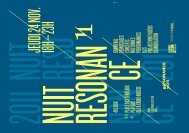Retour en Avant / Past Forward Biennale de la Danse Lyon - France
Retour en Avant / Past Forward Biennale de la Danse Lyon - France
Retour en Avant / Past Forward Biennale de la Danse Lyon - France
- No tags were found...
You also want an ePaper? Increase the reach of your titles
YUMPU automatically turns print PDFs into web optimized ePapers that Google loves.
Dominique Bagouet (1951-1992)Né le 9 juillet 1951 à Angoulême, DominiqueBagouet reçoit à Cannes une formationc<strong>la</strong>ssique dans l’école <strong>de</strong> Rosel<strong>la</strong> Hightower,avant d’obt<strong>en</strong>ir ses premiers <strong>en</strong>gagem<strong>en</strong>tsau Ballet du Grand Théâtre <strong>de</strong> G<strong>en</strong>èvedirigé par Alfonso Cata où, quelques sixmois plus tard, il danse dans un programme<strong>de</strong> Ba<strong>la</strong>nchine. Il passe une audition chezFélix B<strong>la</strong>ska, puis va chez Maurice Béjart àBruxelles. En quête <strong>de</strong> nouveauté, il participeà l’atelier que Carolyn Carlson ouvreà l’Opéra <strong>de</strong> Paris, fait partie <strong>de</strong> Chandra,groupe autonome avec <strong>de</strong>s anci<strong>en</strong>s <strong>de</strong>Mudra dont Micha van Hoecke. Dès 1974,il reçoit l’<strong>en</strong>seignem<strong>en</strong>t int<strong>en</strong>sif <strong>de</strong> CarolynCarlson, <strong>de</strong> Peter Goss et part aux Etats-Unis.Dans <strong>la</strong> foulée Limon, il choisit <strong>de</strong> travailleravec J<strong>en</strong>nifer Muller et Lar Lubovitch. ANew-York, il pr<strong>en</strong>d les cours <strong>de</strong> c<strong>la</strong>ssique<strong>de</strong> Maggie B<strong>la</strong>ck, le professeur <strong>de</strong> tous lesdanseurs contemporains, <strong>en</strong> particulier ceux<strong>de</strong> Cunningham. De retour <strong>en</strong> <strong>France</strong> <strong>en</strong>1976, il prés<strong>en</strong>te sa première chorégraphie,Chansons <strong>de</strong> nuit, au Concours <strong>de</strong> Bagnolet,pour <strong>la</strong>quelle il obti<strong>en</strong>t le premier prix. Ilfon<strong>de</strong> à Montpellier <strong>la</strong> Compagnie DominiqueBagouet, et <strong>de</strong>vi<strong>en</strong>t directeur, dès 1980,<strong>de</strong> l’un <strong>de</strong>s premiers C<strong>en</strong>tres Chorégraphiquesrégionaux, rebaptisé C<strong>en</strong>tre ChorégraphiqueNational <strong>de</strong> Montpellier <strong>en</strong> 1984. Lescréations s’<strong>en</strong>chaîn<strong>en</strong>t rapi<strong>de</strong>m<strong>en</strong>t. DominiqueBagouet crée près d’une quarantaine <strong>de</strong>pièces <strong>en</strong> moins <strong>de</strong> quinze ans. Il participe àplusieurs mises <strong>en</strong> scène <strong>de</strong> théâtre et d’opéras,il co-réalise <strong>de</strong>ux films, il col<strong>la</strong>bore à <strong>de</strong>schorégraphies collectives. Sa disparition <strong>en</strong>1992 a posé avec brutalité le problème <strong>de</strong> <strong>la</strong>préservation et <strong>de</strong> <strong>la</strong> transmission d’un patrimoinechorégraphique marquant dans ledomaine <strong>de</strong> <strong>la</strong> danse contemporaine. Des interprèteset col<strong>la</strong>borateurs <strong>de</strong> <strong>la</strong> CompagnieBagouet se sont mis au travail <strong>en</strong> créantl’association Les Carnets Bagouet qui a pourvocation <strong>de</strong> coordonner et <strong>de</strong> réaliser toutesles initiatives à pr<strong>en</strong>dre dans le domaine<strong>de</strong> <strong>la</strong> transmission. Le fonds d’archives estimm<strong>en</strong>se, il reflète l’int<strong>en</strong>se activité créatricedu chorégraphe et <strong>de</strong> sa compagnie.Comm<strong>en</strong>t le passé peut-il <strong>de</strong>ssiner le futur ?Il ne faudrait pas que le passé façonne le futur <strong>en</strong>conduisant à d’éternelles redites.En revanche, il est nécessaire <strong>de</strong> connaître le passé,s’<strong>en</strong> inspirer parfois et s’<strong>en</strong> libérer toujours.Si les artistes qui nous ont précédés ont ouvert<strong>de</strong>s chemins nouveaux, tracé <strong>de</strong>s pistes que nouscontinuons à emprunter ou à admirer, les artistes et lespublics d’aujourd’hui doiv<strong>en</strong>t <strong>en</strong>tret<strong>en</strong>ir une mémoireactive et critique.L’abs<strong>en</strong>ce <strong>de</strong> mémoire, le rejet ou le r<strong>en</strong>iem<strong>en</strong>t <strong>de</strong>l’Histoire conduit à <strong>la</strong> folie, aux pires <strong>de</strong>s réactions, auconformisme et aux catastrophes.N’opposons pas passé et futur, ce sont les <strong>de</strong>ux termesconsubstantiels <strong>en</strong>tre lesquels notre consci<strong>en</strong>ce etnotre compréh<strong>en</strong>sion du prés<strong>en</strong>t pr<strong>en</strong>n<strong>en</strong>t forme etnous ouvr<strong>en</strong>t <strong>la</strong> liberté.Didier DeschampsInfos +Recréation pour <strong>la</strong> Bi<strong>en</strong>nale <strong>de</strong> <strong>la</strong> <strong>Danse</strong>Compagnie invitée <strong>en</strong> 2002www.ballet-<strong>de</strong>-lorraine.comwww.lescarnetsbagouet.orgC<strong>en</strong>tre ChorégraphiqueNational - Ballet <strong>de</strong> LorraineBallet <strong>de</strong> Lorraine was foun<strong>de</strong>d on 1 September1978 as Théâtre Français <strong>de</strong> Nancy, as part of<strong>France</strong>’s drive to <strong>de</strong>c<strong>en</strong>tralise choreographic activity.Un<strong>de</strong>r its first artistic director, Jean-AlbertCartier, its role was to disseminate choreographyand conduct outreach activities in Nancy and thewi<strong>de</strong>r Lorraine region, and to pres<strong>en</strong>t the companyand its repertoire in <strong>France</strong> and abroad.In December 1987, Théâtre Français <strong>de</strong> Nancy’sboard of directors <strong>de</strong>ci<strong>de</strong>d to change its nameto Ballet Français <strong>de</strong> Nancy. A month <strong>la</strong>ter, Jean-Albert Cartier was appointed to head the Pa<strong>la</strong>isGarnier and the City of Paris festival. His post asBallet Français <strong>de</strong> Nancy’s artistic director w<strong>en</strong>tto Patrick Dupond, danseur étoile at Ballet <strong>de</strong>l’Opéra <strong>de</strong> Paris. Led by the fiery and <strong>de</strong>terminedDupond, Ballet Français <strong>de</strong> Nancy performed onthe world’s greatest stages and offered qualityprogramming that matched its ambition tonurture and disseminate choreography.In April 1991, Patrick Dupond was promoted tobe Director of Dance at the Opéra <strong>de</strong> Paris, andwas succee<strong>de</strong>d by Pierre Lacotte. The Nancy Balletwas awar<strong>de</strong>d “national” status and took thetitle of Ballet National <strong>de</strong> Nancy et <strong>de</strong> Lorraine.The repertoire now embraced not just contemporaryworks but also the c<strong>la</strong>ssical and romanticmasterpieces that sealed Lacotte’s internationalreputation. In June 1999, Lacotte left Ballet National<strong>de</strong> Nancy et <strong>de</strong> Lorraine. Ke<strong>en</strong> to radicallyalter its dance style, it changed names again, becomingC<strong>en</strong>tre Chorégraphique National - Ballet<strong>de</strong> Lorraine. This marked a shift in focus towardscontemporary dance and creating choreographicwork. Françoise Adret, at first appointed actingartistic director for a one-year period, succee<strong>de</strong>dPierre Lacotte and worked to disseminate andincrease appreciation of contemporary dance. InMarch 2000, Didier Deschamps was named g<strong>en</strong>eralmanager of C<strong>en</strong>tre Chorégraphique National- Ballet <strong>de</strong> Lorraine. In just a few years, Ballet<strong>de</strong> Lorraine had become one of <strong>France</strong>’s leadingcompanies for new and repertoire works. It gives70 performances a year on average, typicallywith several items on the bill. Repertoire pieces– both c<strong>la</strong>ssical and contemporary – as well asnew work are p<strong>la</strong>ced in perspective and offerthe public a broad array of techniques, <strong>la</strong>nguagesand creative approaches by today’s artists,illustrating the extraordinary diversity and richesof dance. Highly-r<strong>en</strong>owned choreographersand rising tal<strong>en</strong>ts from around the world cometo Nancy, accompanied by their artistic andtechnical teams. They pass on their i<strong>de</strong>as andcreate work with the Ballet’s performers, whoare all c<strong>la</strong>ssically trained but perfectly versed in,and passionate about, curr<strong>en</strong>t <strong>la</strong>nguages andapproaches.Les petites pièces <strong>de</strong> Berlin /1998, recreated in 2008First performed almost exactly 20 years ago atthe Bi<strong>en</strong>nale <strong>de</strong> <strong>la</strong> <strong>Danse</strong> <strong>de</strong> <strong>Lyon</strong>, Les petitespièces <strong>de</strong> Berlin is the second work by DominiqueBagouet to <strong>en</strong>ter Ballet <strong>de</strong> Lorraine’s repertoireafter Une danse b<strong>la</strong>nche avec Eliane.Although each of Dominique Bagouet’s piecesis singu<strong>la</strong>r, this one is particu<strong>la</strong>rly so owing toits method of composition, which involved thedirect creative input of its initial performers. Theg<strong>en</strong>eral tone of the piece – fairly light, strange,and occasionally comic – does not preclu<strong>de</strong> realint<strong>en</strong>sity and <strong>de</strong>pth in the succession of statesand situations, supported by a warm stage<strong>de</strong>sign and costumes and an original score.There are works that take you on a journey, that<strong>de</strong>light and stimu<strong>la</strong>te you. Les petites pièces <strong>de</strong>Berlin is a very fine example.Dominique Bagouet (1951-1992)Born on 9 July 1951 in Angoulême, DominiqueBagouet received a c<strong>la</strong>ssical training at Rosel<strong>la</strong>Hightower’s school in Cannes, before his first<strong>en</strong>gagem<strong>en</strong>ts at Ballet du Grand Théâtre <strong>de</strong> G<strong>en</strong>ève(director: Alfonso Cata), where, six months<strong>la</strong>ter, he danced in a Ba<strong>la</strong>nchine programme. Heauditioned for Félix B<strong>la</strong>ska, th<strong>en</strong> joined MauriceBéjart in Brussels. Seeking new influ<strong>en</strong>ces, hetook part in Carolyn Carlson’s new workshopat Opéra <strong>de</strong> Paris; and joined Chandra, anin<strong>de</strong>p<strong>en</strong>d<strong>en</strong>t group formed by Mudra alumniincluding Micha van Hoecke. In 1974, hereceived int<strong>en</strong>sive tuition from Carolyn Carlsonand Peter Goss, and left for the United States. InJosé Limon’s slipstream, he worked with J<strong>en</strong>niferMuller and Lar Lubovitch. In New York he tookc<strong>la</strong>ssical c<strong>la</strong>sses with Maggie B<strong>la</strong>ck, the teacherof all contemporary dancers, especially Cunningham’s.Returning to <strong>France</strong> in 1976, he showedhis first work of choreography, Chansons d<strong>en</strong>uit, at the Bagnolet Competition, winning firstprize. In Montpellier he foun<strong>de</strong>d Compagnie DominiqueBagouet, and in 1980 became directorof one of the first regional choreographic c<strong>en</strong>tres,r<strong>en</strong>amed C<strong>en</strong>tre Chorégraphique National<strong>de</strong> Montpellier in 1984. Bagouet was a prolificcreator – almost 40 pieces in less than 15 years.He took part in several stagings of p<strong>la</strong>ys andoperas, co-directed two films, and col<strong>la</strong>boratedon collective choreographies. His <strong>de</strong>ath in 1992raised starkly the problem of preserving andpassing on a choreographic legacy that was a<strong>la</strong>ndmark in contemporary dance. CompagnieBagouet performers and col<strong>la</strong>borators foun<strong>de</strong>da non-profit organisation, Les Carnets Bagouet,to coordinate and carry out all the initiativesnecessary to perpetuate his work. Its imm<strong>en</strong>searchive reflects the int<strong>en</strong>se creative activity ofthe choreographer and his company.How can the past shape the future?The past must not fashion the future by leading toeternal repetition. However, it is necessary to know thepast, to draw occasional inspiration from it, and to beliberated from it at all times.If the artists who prece<strong>de</strong>d us op<strong>en</strong>ed up new pathsand ma<strong>de</strong> tracks that we continue to borrow and admire,th<strong>en</strong> today’s artists and audi<strong>en</strong>ces must maintainan active and critical memory. The abs<strong>en</strong>ce of memory,and the rejection or d<strong>en</strong>ial of History, leads to madnessand the worst kind of reactions; to conformism anddisasters. Let us not set past and future against oneanother; they are consubstantial terms betwe<strong>en</strong> whichare consci<strong>en</strong>ce and our un<strong>de</strong>rstanding of the pres<strong>en</strong>ttake form and op<strong>en</strong> the door to freedom.Didier DeschampsExtra info:Work recreated for the 2008 Bi<strong>en</strong>nalewww.ballet-<strong>de</strong>-lorraine.comwww.lescarnetsbagouet.org27








